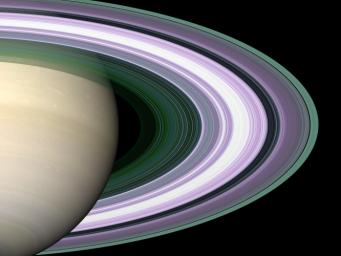
|
Radio Occultation: Unraveling Saturn’s Rings
- Click the image above for a larger view
- Full-Res JPEG (3200 x 2400) (664.6 kB)
- Full-Res TIFF (3200 x 2400) (23.0 MB)
Caption:
Specially designed Cassini orbits place Earth and Cassini on opposite sides of Saturn's rings, a geometry known as occultation. Cassini conducted the first radio occultation observation of Saturn's rings on May 3, 2005.
Three simultaneous radio signals of 0.94, 3.6, and 13 centimeter wavelength (Ka-, X-, and S-bands) were sent from Cassini through the rings to Earth. The observed change of each signal as Cassini moved behind the rings provided a profile of the distribution of ring material as a function of distance from Saturn, or an optical depth profile.
This simulated image was constructed from the measured optical depth profiles. It depicts the observed ring structure at about 10 kilometers (6 miles) in resolution. Color is used to represent information about ring particle sizes in different regions based on the measured effects of the three radio signals.
Purple color indicates regions where there is a lack of particles of size less than 5 centimeters (about 2 inches). Green and blue shades indicate regions where there are particles smaller than 5 centimeters (2 inches) and 1 centimeter (less than one third of one inch). The saturated broad white band near the middle of ring B is the densest region of ring B, over which two of the three radio signals were blocked at 10-kilometer (6-mile) resolution, preventing accurate color representation over this band. From other evidence in the radio observations, all ring regions appear to be populated by a broad range particle size distribution that extends to boulder sizes (several to many meters across).
Background Info:
The Cassini-Huygens mission is a cooperative project of NASA, the European Space Agency and the Italian Space Agency. The Jet Propulsion Laboratory, a division of the California Institute of Technology in Pasadena, manages the mission for NASA's Science Mission Directorate, Washington, D.C. The Cassini orbiter was designed, developed and assembled at JPL. The radio science team is based at JPL.
For more information about the Cassini-Huygens mission visit http://saturn.jpl.nasa.gov . For more information on the radio science team visit http://saturn.jpl.nasa.gov/spacecraft/instruments-cassini-rss.cfm .
Cataloging Keywords:
| Name | Value | Additional Values |
|---|---|---|
| Target | Saturn | Saturn Rings |
| System | Saturn | |
| Target Type | Planet | Ring |
| Mission | Cassini-Huygens | |
| Instrument Host | Cassini Orbiter | |
| Host Type | Orbiter | |
| Instrument | Radioscience Subsystem (RSS) | |
| Detector | ||
| Extra Keywords | Color, Disk, Occultation, Radio, Wave | |
| Acquisition Date | ||
| Release Date | 2005-05-23 | |
| Date in Caption | 2005-05-03 | |
| Image Credit | NASA/JPL | |
| Source | photojournal.jpl.nasa.gov/catalog/PIA07873 | |
| Identifier | PIA07873 | |
